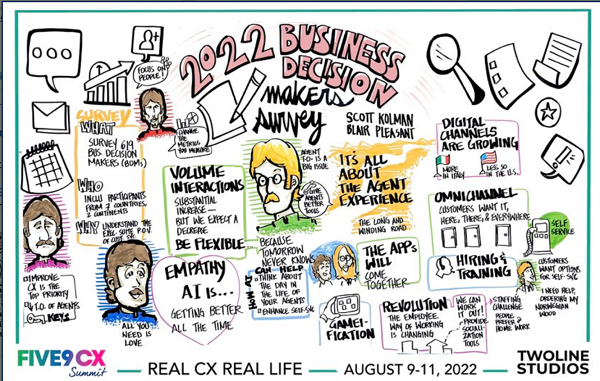In an effort to understand what today’s business decision-makers are thinking about regarding customer service, contact center technologies, employee retention, and the changing contact center environment, Five9 partnered with Zogby Analytics to survey business decision-makers about the state of customer service and support. These business decision-makers—CXOs, business owners, and organization leaders with decision-making responsibilities—from companies with 250 or more employees, representing seven countries, were asked a range of questions focusing on how customer service roles and interactions are changing; how AI is part of omnichannel customer experiences; what factors are impacting the agent experience and contact center effectiveness.
As the author of the
report presenting the survey results, I had the opportunity to drill down into the findings to understand (or try to understand) the issues most concerning to contact center business decision makers, their expectations for the future, and their views on various technologies. This year’s survey included several European countries, and it was especially interesting to note the differences between regions and countries.
Scott Kolman, Five9 senior vice president of marketing, and I presented the survey results at the Five9 CX Summit in Las Vegas last month. We highlighted some of the key findings with Beatles song references: As an example, we discussed how AI and self-service are “Getting Better All the Time” and can “Help” improve the customer experience, while customers like self-service because they can get service 24 hours a day, “Eight Days a Week.”
When presenting the survey results, we discussed how some of the findings surprised us while some we expected.
What Did and Didn’t Surprise Us
As expected, an overwhelming majority of surveyed decision-makers reported moderate or substantial increases in contact center interaction volume.
When asked about the changing role of customer service representatives over the past 24 months; 53% of respondents noted that agents need to have emotional intelligence & empathy. Since the start of the pandemic, empathy has taken center stage, as customers want to interact with agents who are truly listening to them and trying to solve their issue rather than just rushing to the next call. 52% of respondents acknowledged that agents now need to support various interaction channels, followed by 43% responding that agent interactions have become lengthier and more complex.
Also, as anticipated, the overwhelming majority of respondents noted that their companies provide omnichannel experiences to their customer. Customer interactions are increasingly taking place over non-voice digital channels, and more than two-thirds of the respondents expect digital interactions to exceed 40% by 2024. We were somewhat pleased but also surprised to learn that only 5% of the respondents’ organizations support voice-only channels.
Almost half of the respondents acknowledged that customer interactions are getting more complex and longer. Again – no surprises here. With bots and self-service technologies handling the easy questions and issues, agents are handling the more complex customer interactions.
While we expected to see respondents acknowledge that self-service interactions are on the rise, we were surprised that 15% of business decision-makers expect 81-100% of interactions to be fully handled via self-service.
Perhaps the most unexpected finding from the survey was how much our respondents incorporated AI into their contact centers. Three out of four respondents currently use AI in their contact centers – this is much higher than we expected. Of the 25% who do not, a third or more plan to do so in the next 12 months.
Globally, 73% of business decision-makers currently use AI in their contact centers, and only 18% have no plans for AI. Italy stands out in its adoption of AI technologies, with 87% of the organizations surveyed currently using AI, compared to 63% and 68% in Canada and the U.S., respectively.
Even more surprising was the use of conversational AI for customer self-service (78% globally, 75% in North America, 82% in Europe) and agent assistance to help agents as they interact with customers (90% globally, 89% in North America, 92% in Europe). Since such a high portion of respondents indicated that they are using conversational AI, which is a relatively newer and more advanced capability service, we are assuming that many are including speech-based IVR, which has been around much longer and is more common in contact centers, rather than natural language understanding and machine learning-based conversational AI.
Future Priorities
When asked about key focus areas and priorities for the next 12 months, we were delighted that “improving the customer experience” was at the top of the list, followed closely by “reducing agent/employee turnover,” while “decreasing operational costs” was at the bottom of the list. No longer seen as “cost centers,” today’s contact center is all about customer experience.
Focus on the agent experience is also gaining ground. It was nice to see that nearly all respondents (90% globally, 88% in North America, and 93% in Europe) reported spending more time and attention on agent/employee experience and engagement in the past year.
The Changing Workplace
The second part of the survey focused on the changing workplace. Workers in every industry are slowly returning to the office, and the contact center is no exception. We asked participants about their current contact center staffing situation as it relates to remote work, and the answer was a mixed bag, no matter where respondents were located. Overall, just one-third of companies have all their employees back in the office full-time. The remaining two-thirds were split between returning part-time, working remotely full-time, or giving the agents a choice in where they want to work.
Geographic differences were interesting: Almost half of Italy’s contact center employees have returned to the office full time, and only 18% are in the office part-time, while in Spain, the numbers seem reversed – only 26% of agents returned to the office full time, and 48% are now in the office part-time.
Moving on to contact center operations challenges: Agent retention tops the list, as employees simply don’t want to return to the pre-pandemic norms, and their unwillingness to return to the office full-time is a big challenge, especially in North America. Lack of flexible work options and agent engagement/productivity are bigger challenges in Europe.
And in the End…
This is just a partial view of the entire survey—for the bigger picture, you can read the entire
report here. “
I’ve Got a Feeling” you’ll find it valuable.
This post is written on behalf of BCStrategies, an industry resource for enterprises, vendors, system integrators, and anyone interested in the growing business communications arena. A supplier of objective information on business communications, BCStrategies is supported by an alliance of leading communication industry advisors, analysts, and consultants who have worked in the various segments of the dynamic business communications market.












